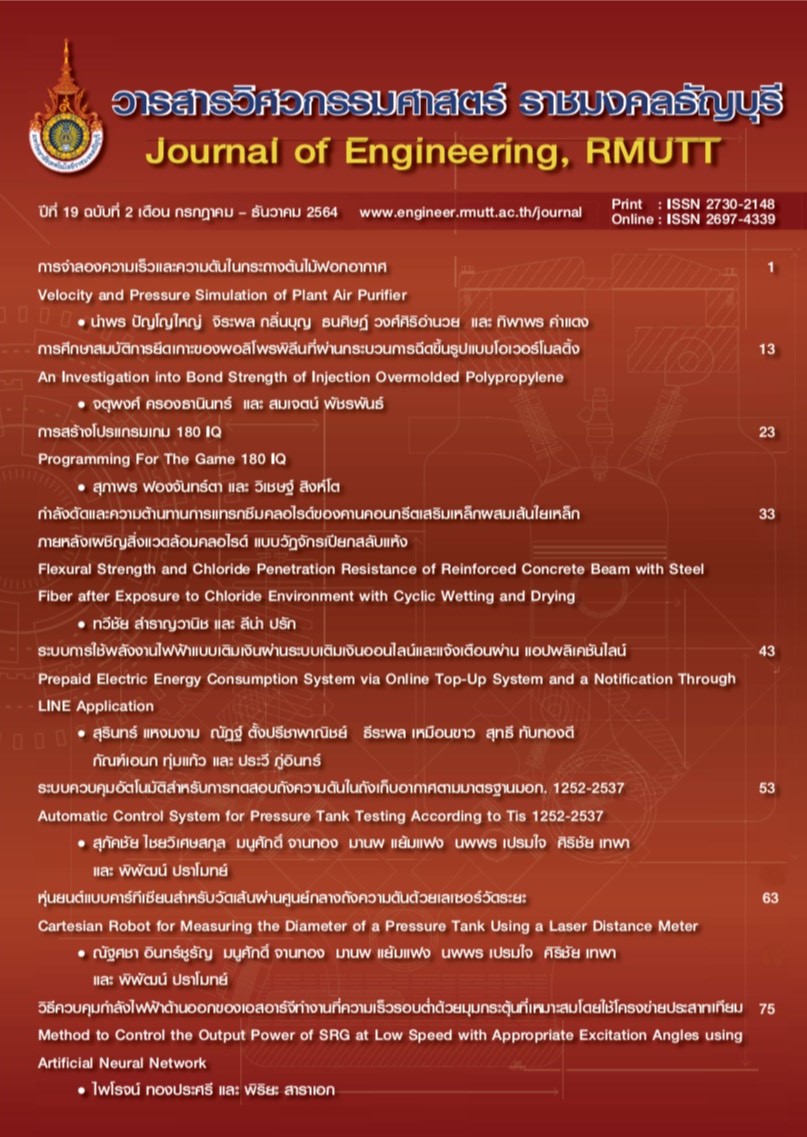Flexural Strength and Chloride Penetration Resistance of Reinforced Concrete Beam with Steel Fiber after Exposure to Chloride Environment with Cyclic Wetting and Drying
Main Article Content
Abstract
This paper aims to study the flexural strength and chloride penetration resistance of reinforced concrete (RC) beam containing steel fiber after exposure to chloride environment with cyclic wetting and drying. The compressive and splitting tensile strengths of concrete containing steel fiber were also studied. Steel fiber was used at the content of 0.50% by volume of the concrete. Compressive and splitting tensile strengths and were tested at the age of 28 days. RC beams' flexural strength was tested after exposure to the cyclic wetting and drying period with 5.0% of chloride solution for two years. The chloride penetration of concrete was investigated. The study results found that the compressive strength of concrete containing steel fiber was similar to control concrete without steel fiber, but the splitting tensile strength of concrete mixed with steel fiber was higher than that without steel fiber. Considering the RC beam's flexural strength after exposure to cyclic wetting and drying, the RC beam's flexural strength with steel fiber was higher than the control RC beam without steel fiber. The RC beam's flexural strength exposed to the chloride environment was lower than that exposed to the water. Besides, RC beams with steel fiber had higher chloride penetration resistance than those without steel fiber.
Article Details
The manuscript, information, content, picture and so forth which were published on Frontiers in engineering innovation research has been a copyright of this journal only. There is not allow anyone or any organize to duplicate all content or some document for unethical publication.
References
Marcos-Meson V, Michel A, Solgaard A, Fischer G, Edvardsen C, Skovhus T.L. Corrosion resistance of steel fibre reinforced concrete – A literature review. Cement and Concrete Research. 2018; 103:1-20.
Pyo S, Koh T, Tafesse M, Kim HK. Chloride-induced corrosion of steel fiber near the surface of ultra-high performance concrete and its effect on flexural behaviour with various thickness. Construction and Building Materials. 2019;224:206-13.
Yoo DY, Shin W, Chun B. Corrosion effect on tensile behaviour of ultra-high performance concrete reinforced with straight steel fibers. Cement and Concrete Composites. 2020;109:103566.
Sumranwanich T, Tangtermsirikul S. Concrete structure deterioration. Bangkok: Charansanitwong Printing; 2018. (in Thai)
Prak L, Sumranwanich T. Chloride binding capacity and water absorption of mortar containing fly ash, limestone powder, and expansive additive. Journal of Engineering, RMUTT. 2020;18(2):133-44. (in Thai)
Prak L, Sumranwanich, T. Investigation of Chloride Penetration and Steel Corrosion in Repaired Concrete after Exposure to Marine Environment of Thailand. Journal of Engineering, RMUTT. 2020;18(1);165-73.
Arttamart S, Sumranwanich T. Compressive strength and chloride penetration resistance of concrete with fly ash, limestone powder and partial replacement of fine aggregate by bottom ash. Journal of Engineering, RMUTT. 2019;17(2):113-25. (in Thai)
Sumranwanich T, Phuchan A, Manwicha S. Behavior and calculation method of the flexural strength of reinforced concrete beam with fiber. KMUTT Research and Development Journal. 2007;30(2):345-62. (in Thai)
American Society for Testing and Materials. ASTM C39. Standard test method for compressive strength of cylindrical concrete specimens. Annual Book of ASTM Standard. 2004.
American Society for Testing and Materials. ASTM C496. Standard test method for splitting tensile strength of cylindrical concrete specimens. Annual Book of ASTM Standard. 2004.
American Society for Testing and Materials. ASTM C78. Standard test method for flexural strength of concrete (using simple beam with third-point loading). Annual Book of ASTM Standard. 2004.
Zheng Y, Wu X, He G, Shang Q, Xu J, Sun Y. Mechanical properties of steel fiber-reinforced concrete by vibratory mixing technology. Advances in Civil Engineering. 2018:1-11.
American Society for Testing and Materials. ASTM C1152. Standard test method for acid-soluble chloride in mortar and concrete. Annual Book of ASTM Standards. 2004.
Prak L, Sumranwanich T. Compressive strength and water permeability of concrete mixed with steel fiber. In: Proceedings of the 25th National Convention of Civil Engineering; 2020 Jul 15-17; Chonburi, Thailand. p. 1826-30. (in Thai)


